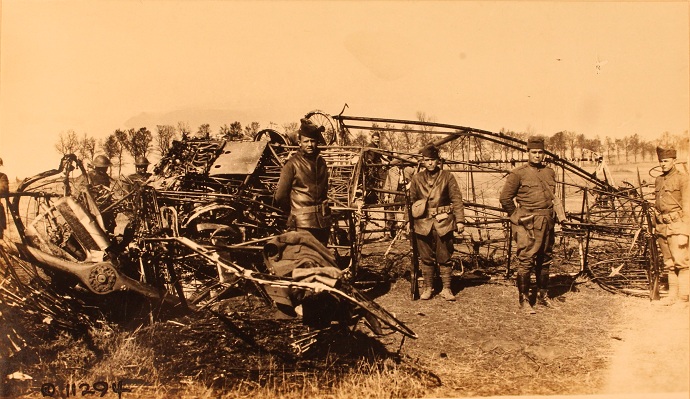By John F. Ross
When brand new technology first appears it’s often striking in retrospect to see that so many seemingly commonsense safety measures frequently take years to develop. World War 1 ace and race driver Eddie Rickenbacker knew this all too well, first as a race car driver in the new world of auto racing, where many years passed before the racing community adopted many already existing safety features, including rear view mirrors, seat belts, and hard helmets. A mechanician sat next to the driver, much of his job to alert his companion to cars coming from behind. Both driver and mechanician frequently paid the ultimate price for lack of such safety gear when their cars hit another one or went into a barrier: the men were often launched like projectiles in the air.
But perhaps no technological oversight seems more outrageous than the official American policy on pilots wearing parachutes during World War 1.
Early aircraft were little more than flying deathtraps, the dry wooden frames and spars of their crafts covered in fabric doped with a highly flammable stiffening agent. It’s difficult to imagine a more flammable pyre—and that’s even before the spark-spitting engine was added. Pilots controlled air speed in the early rotary engines by means of blip switch that turned off the engine for a second or two. When the engine was off, fuel kept pumping into the engine and collected unburned in the cowling. Such fuel exploded when a pilot took his thumb off the switch and turned the engine back on. Too heavy a thumb on the blip switch could bring disaster. Of course the greatest fire threat lay in the rounds fired from an enemy airship, which could easily set the main or auxiliary gas tank afire.

World War 1 German plane wreckage, March 12, 1918, near Soissons, France. (Courtesy: National Archives, College Park, MD)
Each pilot seriously considered his options should fire break out miles above the Earth. He would have little time to decide; such a wind-blown inferno was capable of consuming the aeroplane within minutes, leaving a terribly-burned pilot to tumble helplessly to the ground.
Ace Raoul Lufbery told Rickenbacker that he’d never jump but try to maneuver his plane so as to extinguish the flames. Others vowed to exercise their last shred of human dignity and decide their own fate by jumping overboard. Still others took their service pistol aboard for another grisly option. Yet for all of their bravura, none of these young pilots quite knew what he would do if faced with such a desperate situation.
Most of these conversations would have been rendered mute had headquarters issued parachutes. Parachutes did exist, although rudimentary by today’s standards. Men in observation balloons used them throughout the war to escape when enemy aircraft set their gasbags ablaze. During the last six weeks of the war, German aviators donned them and Eddie saw several deploy. One saved German ace Ernst Udet’s life.
American pilots never wore them because the higher ups—who had never flown themselves before—believed that these devices would make a pilot likely to jump out at the first hint of danger. Too many planes would be lost.
“We knew [parachutes] were being worked on,” noted Doug Campbell, the first ace in American service, “and we didn’t know why we didn’t have them…we would have been glad to have them.” After the fatal collision of two American pilots he knew, Eddie despaired, falling into “a very bad state of mind” to think that this relatively cheap technology would “without question” have saved the two men’s lives. “Cannot help but feel,” Eddie confided to his journal, “that it was criminal negligence on the part of those higher up for not having exercised sufficient forethought and seeing that we were equipped with parachutes for just such emergencies.”
The courage of Eddie Rickenbacker and the young men flying those dangerous, new machines in war is extraordinary. When one realizes that they did so even when denied life-saving technology makes their efforts even more remarkable.
The understanding that pilots were difficult to train and far more valuable than aircraft didn’t sink in until a year after World War 1 ended. Parachutes were then issued.
Please check out this interview with John F. Ross on his upcoming book, Enduring Courage.
JOHN F. ROSS is the author of War on the Run: The Epic Story of Robert Rogers and the Conquest of America’s First Frontier. Winner of the Fort Ticonderoga Prize for Contributions to American History, he has served as the Executive Editor of American Heritage and on the Board of Editors at Smithsonian magazine. His latest book is Enduring Courage: Ace Pilot Eddie Rickenbacker and the Dawn of the Age of Speed.
